NISSAN LEAF 2017 1.G Roadside Assistance Guide
Manufacturer: NISSAN, Model Year: 2017, Model line: LEAF, Model: NISSAN LEAF 2017 1.GPages: 39, PDF Size: 1.32 MB
Page 21 of 39
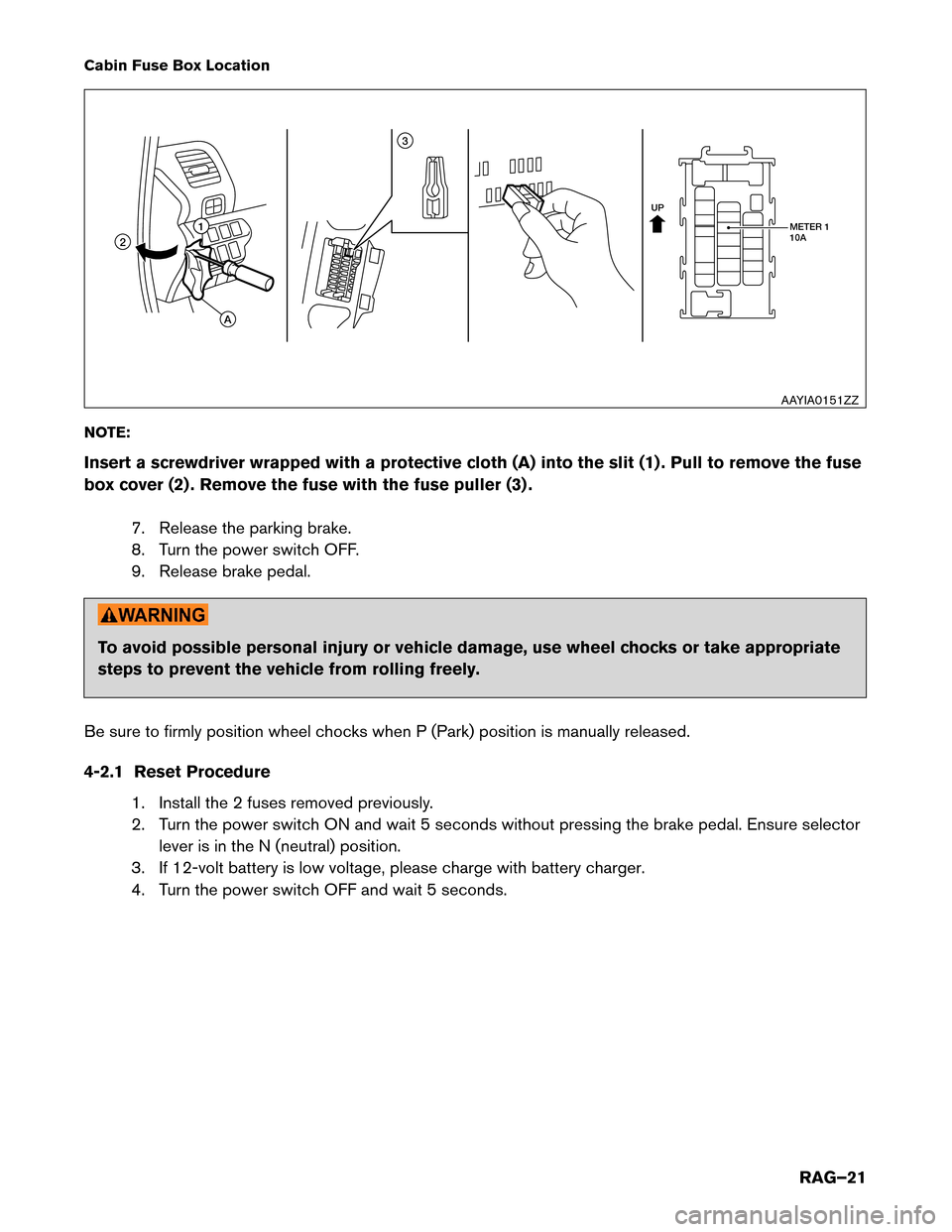
Cabin Fuse Box Location
NO
TE:
Insert a screwdriver wrapped with a protective cloth (A) into the slit (1) . Pull to remove the fuse
box cover (2) . Remove the fuse with the fuse puller (3) .
7. Release the parking brake.
8. Turn the power switch OFF.
9. Release brake pedal. To avoid possible personal injury or vehicle damage, use wheel chocks or take appropriate
steps
to prevent the vehicle from rolling freely.
Be sure to firmly position wheel chocks when P (Park) position is manually released.
4-2.1 Reset Procedure 1. Install the 2 fuses removed previously.
2. Turn the power switch ON and wait 5 seconds without pressing the brake pedal. Ensure selectorlever is in the N (neutral) position.
3. If 12-volt battery is low voltage, please charge with battery charger.
4. Turn the power switch OFF and wait 5 seconds. UP
METER 1
10A
11 3
2
A
AAYIA0151ZZ
RAG–21
Page 22 of 39
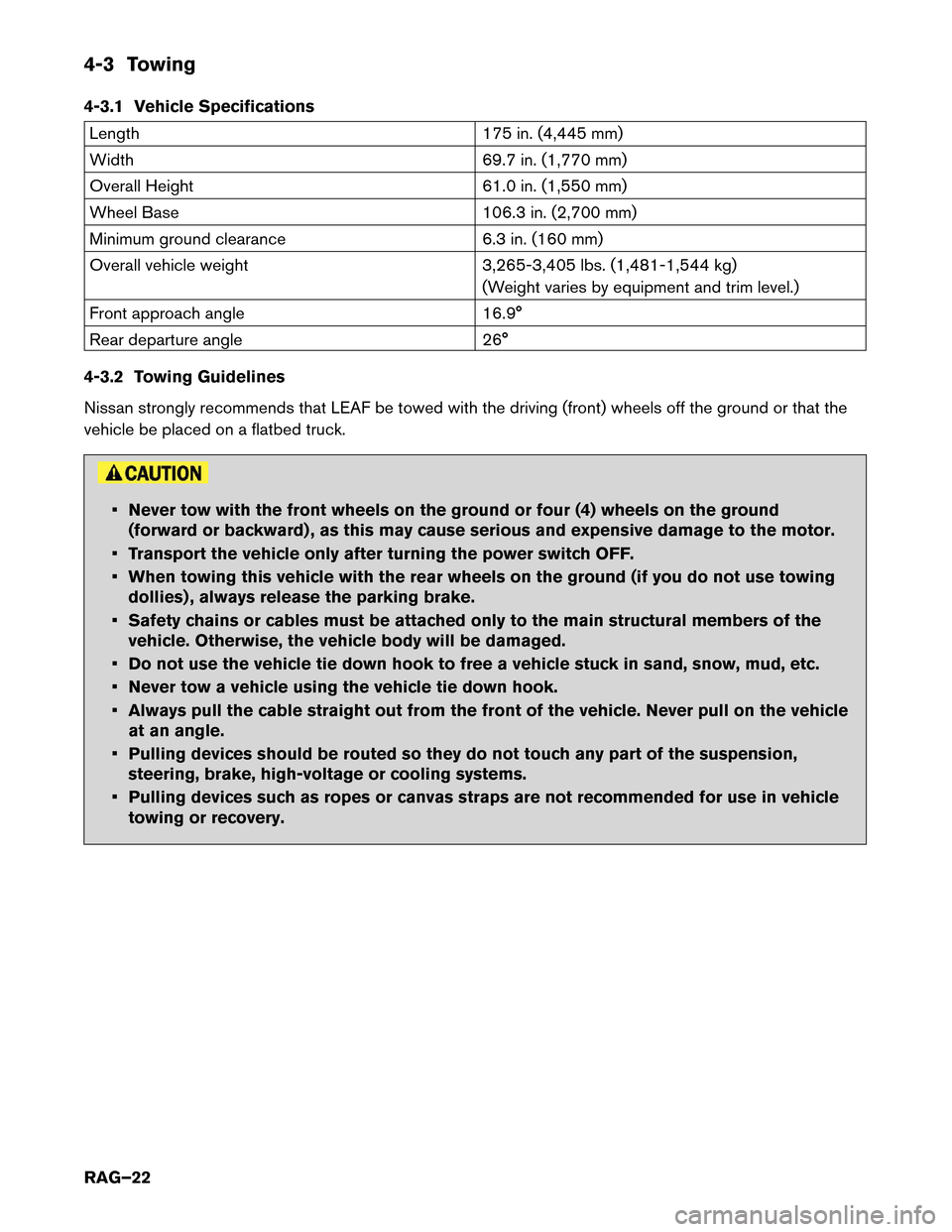
4-3 Towing
4-3.1
Vehicle Specifications Length
175
in. (4,445 mm)
Width 69.7 in. (1,770 mm)
Overall Height 61.0 in. (1,550 mm)
Wheel Base 106.3 in. (2,700 mm)
Minimum ground clearance 6.3 in. (160 mm)
Overall vehicle weight 3,265-3,405 lbs. (1,481-1,544 kg)
(Weight varies by equipment and trim level.)
Front approach angle 16.9°
Rear departure angle 26°
4-3.2 Towing Guidelines
Nissan strongly recommends that LEAF be towed with the driving (front) wheels off the ground or that the
vehicle be placed on a flatbed truck. • Never tow with the front wheels on the ground or four (4) wheels on the ground
(forward
or backward) , as this may cause serious and expensive damage to the motor.
• Transport the vehicle only after turning the power switch OFF.
• When towing this vehicle with the rear wheels on the ground (if you do not use towing dollies) , always release the parking brake.
• Safety chains or cables must be attached only to the main structural members of the vehicle. Otherwise, the vehicle body will be damaged.
• Do not use the vehicle tie down hook to free a vehicle stuck in sand, snow, mud, etc.
• Never tow a vehicle using the vehicle tie down hook.
• Always pull the cable straight out from the front of the vehicle. Never pull on the vehicle at an angle.
• Pulling devices should be routed so they do not touch any part of the suspension, steering, brake, high-voltage or cooling systems.
• Pulling devices such as ropes or canvas straps are not recommended for use in vehicle towing or recovery.
RAG–22
Page 23 of 39
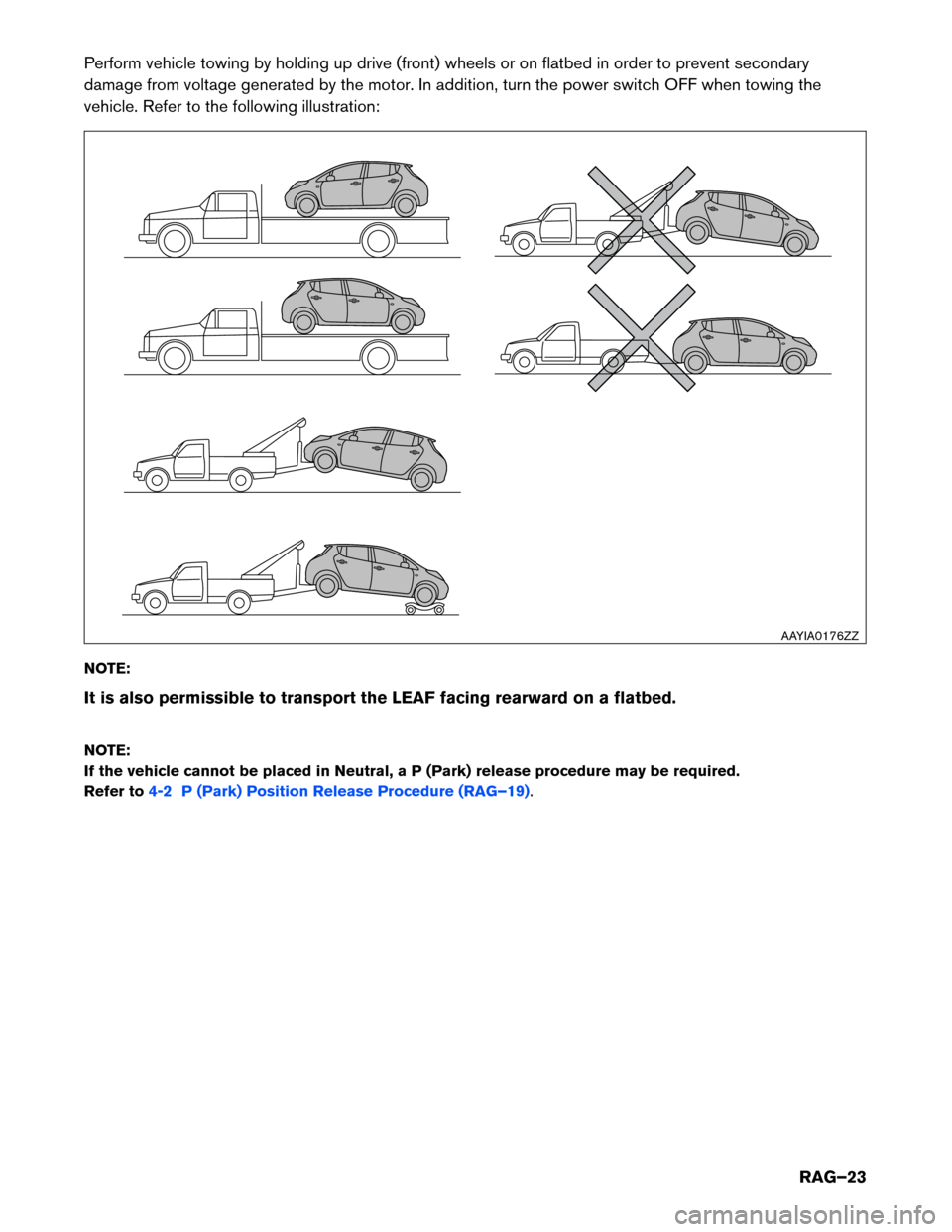
Perform vehicle towing by holding up drive (front) wheels or on flatbed in order to prevent secondary
damage
from voltage generated by the motor. In addition, turn the power switch OFF when towing the
vehicle. Refer to the following illustration:
NOTE:
It is also permissible to transport the LEAF facing rearward on a flatbed.
NOTE:
If the vehicle cannot be placed in Neutral, a P (Park) release procedure may be required.
Refer to 4-2 P (Park) Position Release Procedure (RAG–19). AAYIA0176ZZ
RAG–23
Page 24 of 39
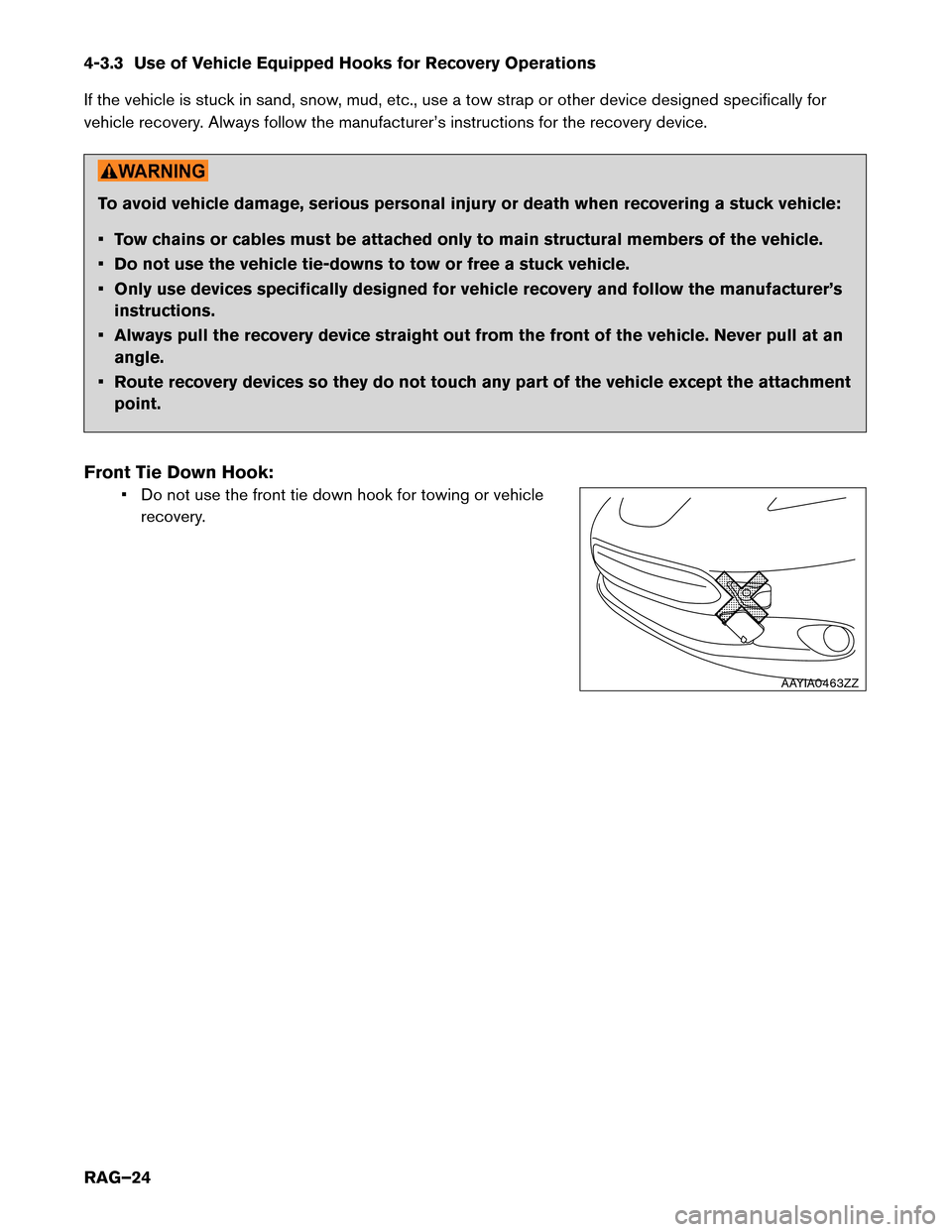
4-3.3 Use of Vehicle Equipped Hooks for Recovery Operations
If
the vehicle is stuck in sand, snow, mud, etc., use a tow strap or other device designed specifically for
vehicle recovery. Always follow the manufacturer’s instructions for the recovery device. To avoid vehicle damage, serious personal injury or death when recovering a stuck vehicle:
•
Tow chains or cables must be attached only to main structural members of the vehicle.
• Do not use the vehicle tie-downs to tow or free a stuck vehicle.
• Only use devices specifically designed for vehicle recovery and follow the manufacturer’s instructions.
• Always pull the recovery device straight out from the front of the vehicle. Never pull at an angle.
• Route recovery devices so they do not touch any part of the vehicle except the attachment point.
Front Tie Down Hook: • Do not use the front tie down hook for towing or vehiclerecovery. AAYIA0463ZZ
RAG–24
Page 25 of 39
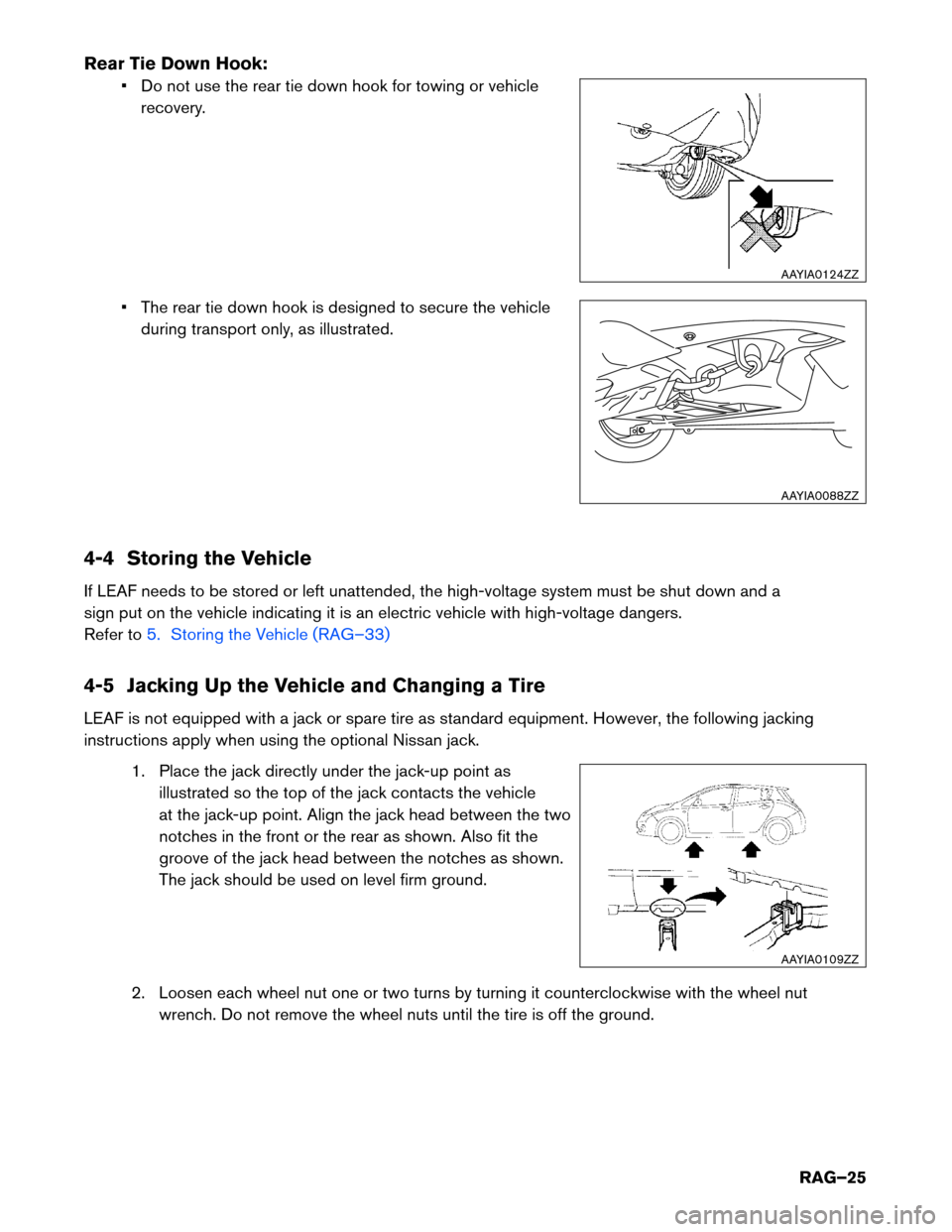
Rear Tie Down Hook:
• Do not use the rear tie down hook for towing or vehicle
recovery.
• The rear tie down hook is designed to secure the vehicle during transport only, as illustrated.
4-4 Storing the Vehicle
If LEAF needs to be stored or left unattended, the high-voltage system must be shut down and a
sign put on the vehicle indicating it is an electric vehicle with high-voltage dangers.
Refer to 5. Storing the Vehicle (RAG–33)
4-5 Jacking Up the Vehicle and Changing a Tire
LEAF
is not equipped with a jack or spare tire as standard equipment. However, the following jacking
instructions apply when using the optional Nissan jack.
1. Place the jack directly under the jack-up point asillustrated so the top of the jack contacts the vehicle
at the jack-up point. Align the jack head between the two
notches in the front or the rear as shown. Also fit the
groove of the jack head between the notches as shown.
The jack should be used on level firm ground.
2. Loosen each wheel nut one or two turns by turning it counterclockwise with the wheel nut wrench. Do not remove the wheel nuts until the tire is off the ground. AAYIA0124ZZ
AAYIA0088ZZ
AAYIA0109ZZ
RAG–25
Page 26 of 39
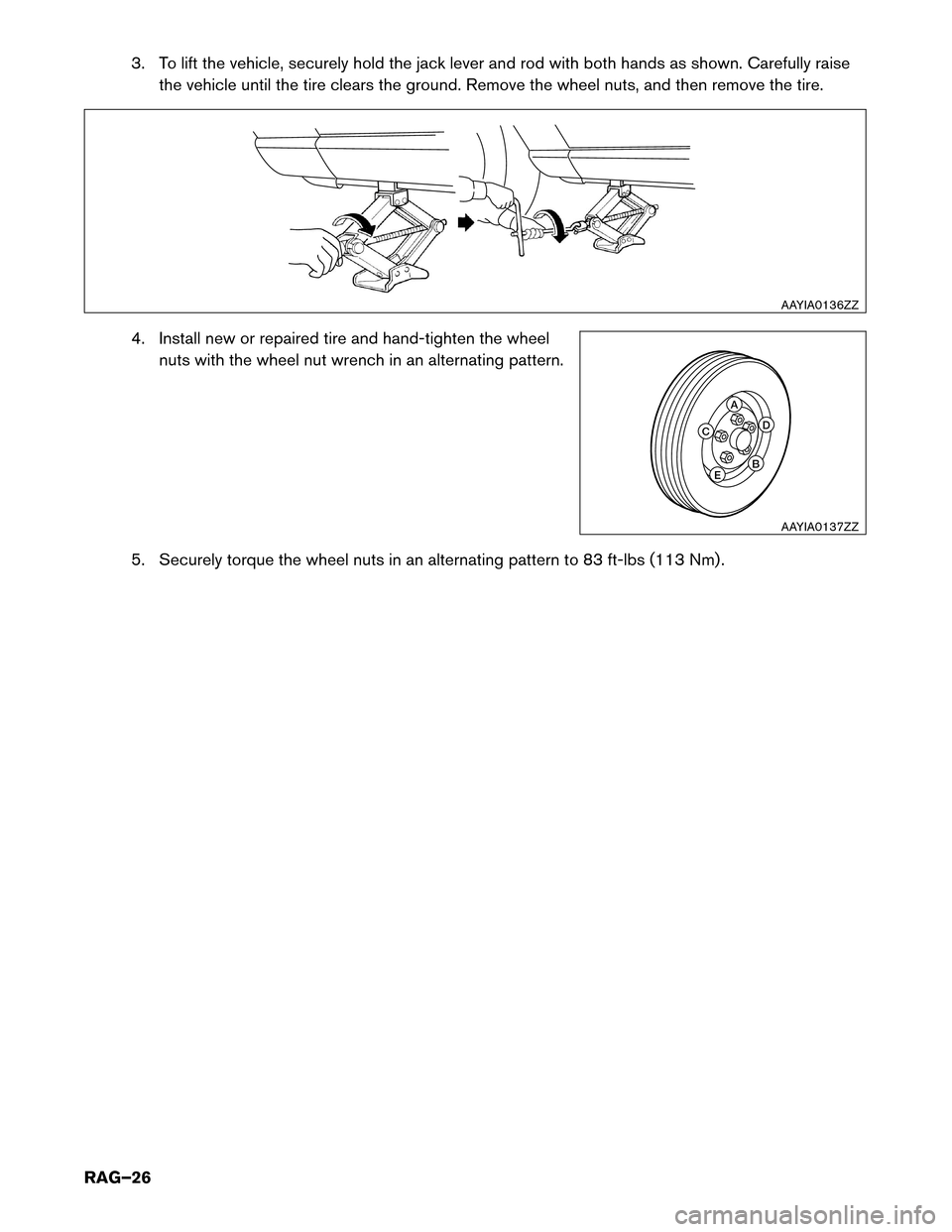
3. To lift the vehicle, securely hold the jack lever and rod with both hands as shown. Carefully raise
the vehicle until the tire clears the ground. Remove the wheel nuts, and then remove the tire.
4. Install new or repaired tire and hand-tighten the wheel nuts with the wheel nut wrench in an alternating pattern.
5. Securely torque the wheel nuts in an alternating pattern to 83 ft-lbs (113 Nm) . AAYIA0136ZZ
B
EC DA
AAYIA0137ZZ
RAG–26
Page 27 of 39
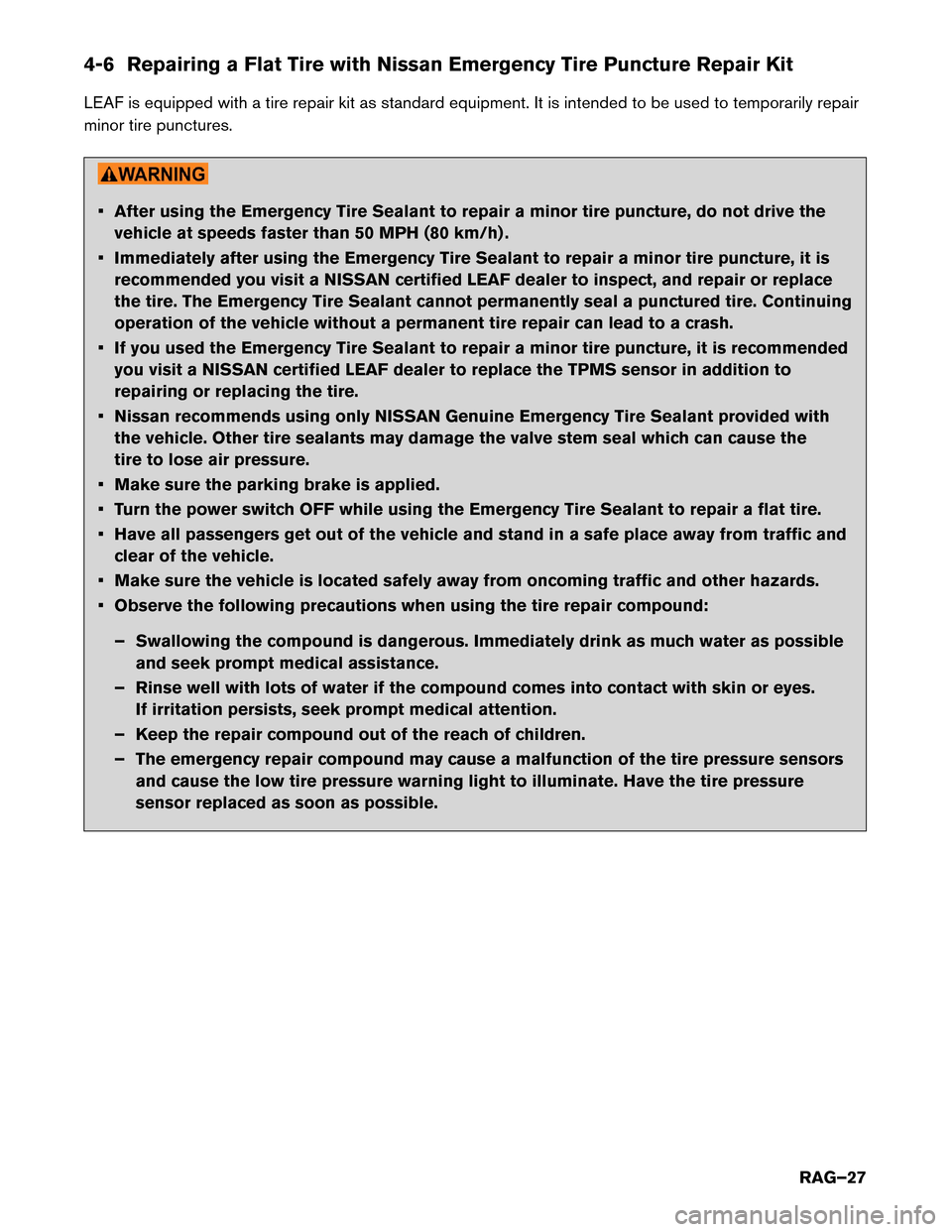
4-6 Repairing a Flat Tire with Nissan Emergency Tire Puncture Repair Kit
LEAF
is equipped with a tire repair kit as standard equipment. It is intended to be used to temporarily repair
minor tire punctures. • After using the Emergency Tire Sealant to repair a minor tire puncture, do not drive the
vehicle
at speeds faster than 50 MPH (80 km/h) .
• Immediately after using the Emergency Tire Sealant to repair a minor tire puncture, it is recommended you visit a NISSAN certified LEAF dealer to inspect, and repair or replace
the tire. The Emergency Tire Sealant cannot permanently seal a punctured tire. Continuing
operation of the vehicle without a permanent tire repair can lead to a crash.
• If you used the Emergency Tire Sealant to repair a minor tire puncture, it is recommended you visit a NISSAN certified LEAF dealer to replace the TPMS sensor in addition to
repairing or replacing the tire.
• Nissan recommends using only NISSAN Genuine Emergency Tire Sealant provided with the vehicle. Other tire sealants may damage the valve stem seal which can cause the
tire to lose air pressure.
• Make sure the parking brake is applied.
• Turn the power switch OFF while using the Emergency Tire Sealant to repair a flat tire.
• Have all passengers get out of the vehicle and stand in a safe place away from traffic and clear of the vehicle.
• Make sure the vehicle is located safely away from oncoming traffic and other hazards.
• Observe the following precautions when using the tire repair compound:
– Swallowing the compound is dangerous. Immediately drink as much water as possible and seek prompt medical assistance.
– Rinse well with lots of water if the compound comes into contact with skin or eyes. If irritation persists, seek prompt medical attention.
– Keep the repair compound out of the reach of children.
– The emergency repair compound may cause a malfunction of the tire pressure sensors and cause the low tire pressure warning light to illuminate. Have the tire pressure
sensor replaced as soon as possible.
RAG–27
Page 28 of 39
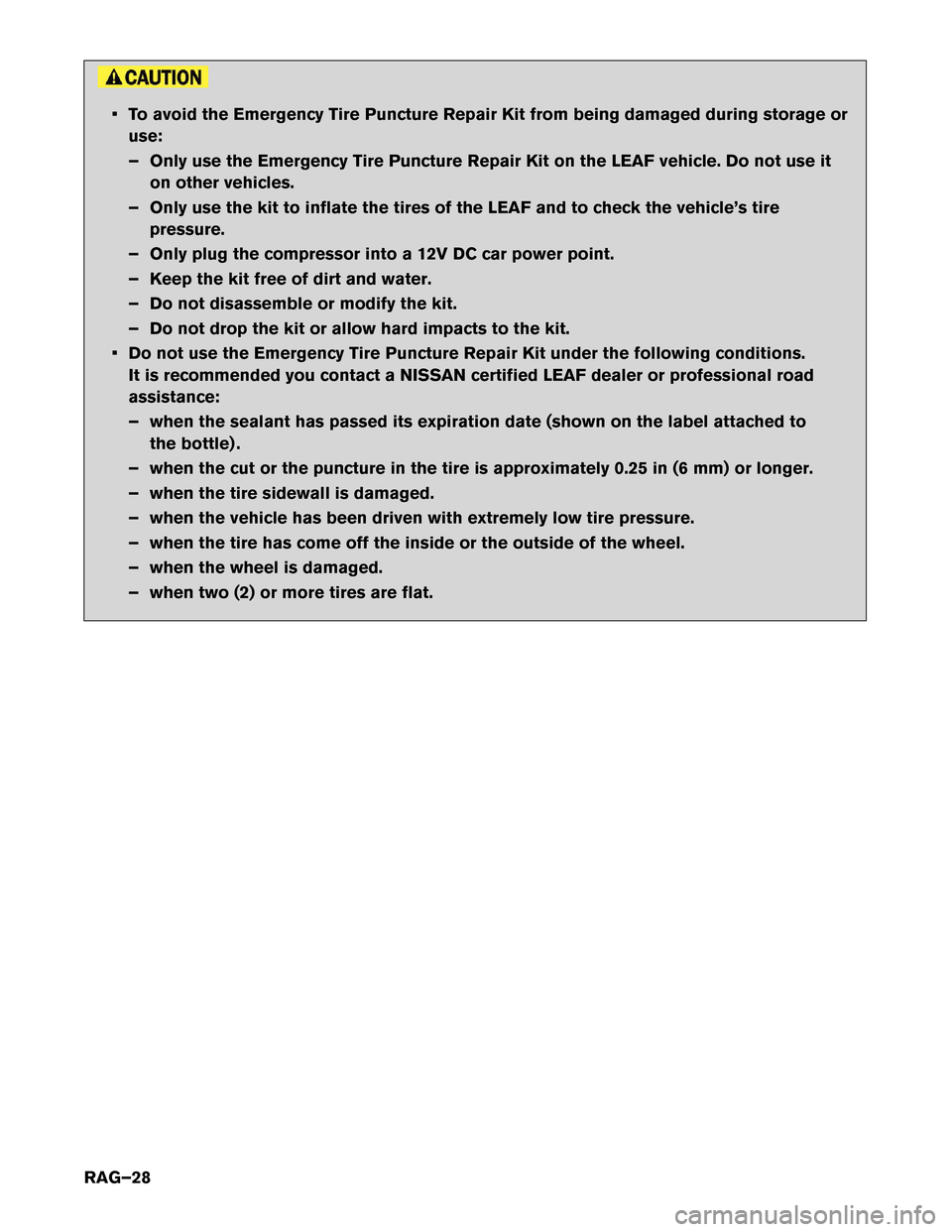
• To avoid the Emergency Tire Puncture Repair Kit from being damaged during storage or
use:
–
Only use the Emergency Tire Puncture Repair Kit on the LEAF vehicle. Do not use it
on other vehicles.
– Only use the kit to inflate the tires of the LEAF and to check the vehicle’s tire pressure.
– Only plug the compressor into a 12V DC car power point.
– Keep the kit free of dirt and water.
– Do not disassemble or modify the kit.
– Do not drop the kit or allow hard impacts to the kit.
• Do not use the Emergency Tire Puncture Repair Kit under the following conditions. It is recommended you contact a NISSAN certified LEAF dealer or professional road
assistance:
– when the sealant has passed its expiration date (shown on the label attached to the bottle) .
– when the cut or the puncture in the tire is approximately 0.25 in (6 mm) or longer.
– when the tire sidewall is damaged.
– when the vehicle has been driven with extremely low tire pressure.
– when the tire has come off the inside or the outside of the wheel.
– when the wheel is damaged.
– when two (2) or more tires are flat.
RAG–28
Page 29 of 39
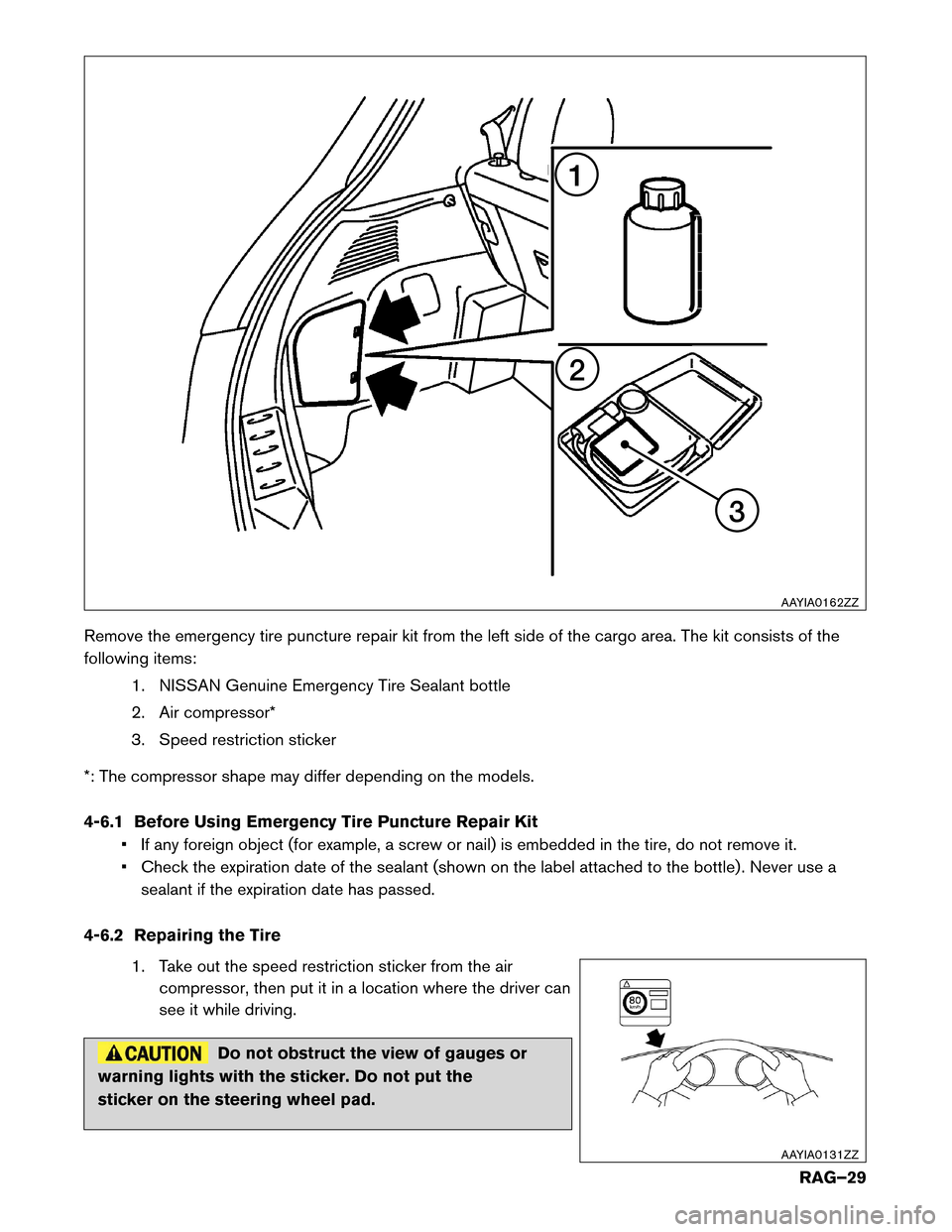
Remove the emergency tire puncture repair kit from the left side of the cargo area. The kit consists of the
following
items:
1. NISSAN Genuine Emergency Tire Sealant bottle
2. Air compressor*
3. Speed restriction sticker
*: The compressor shape may differ depending on the models.
4-6.1 Before Using Emergency Tire Puncture Repair Kit • If any foreign object (for example, a screw or nail) is embedded in the tire, do not remove it.
• Check the expiration date of the sealant (shown on the label attached to the bottle) . Never use asealant if the expiration date has passed.
4-6.2 Repairing the Tire 1. Take out the speed restriction sticker from the aircompressor, then put it in a location where the driver can
see it while driving. Do not obstruct the view of gauges or
warning
lights with the sticker. Do not put the
sticker on the steering wheel pad. 321
AAYIA0162ZZ AAYIA0131ZZ
RAG–29
Page 30 of 39
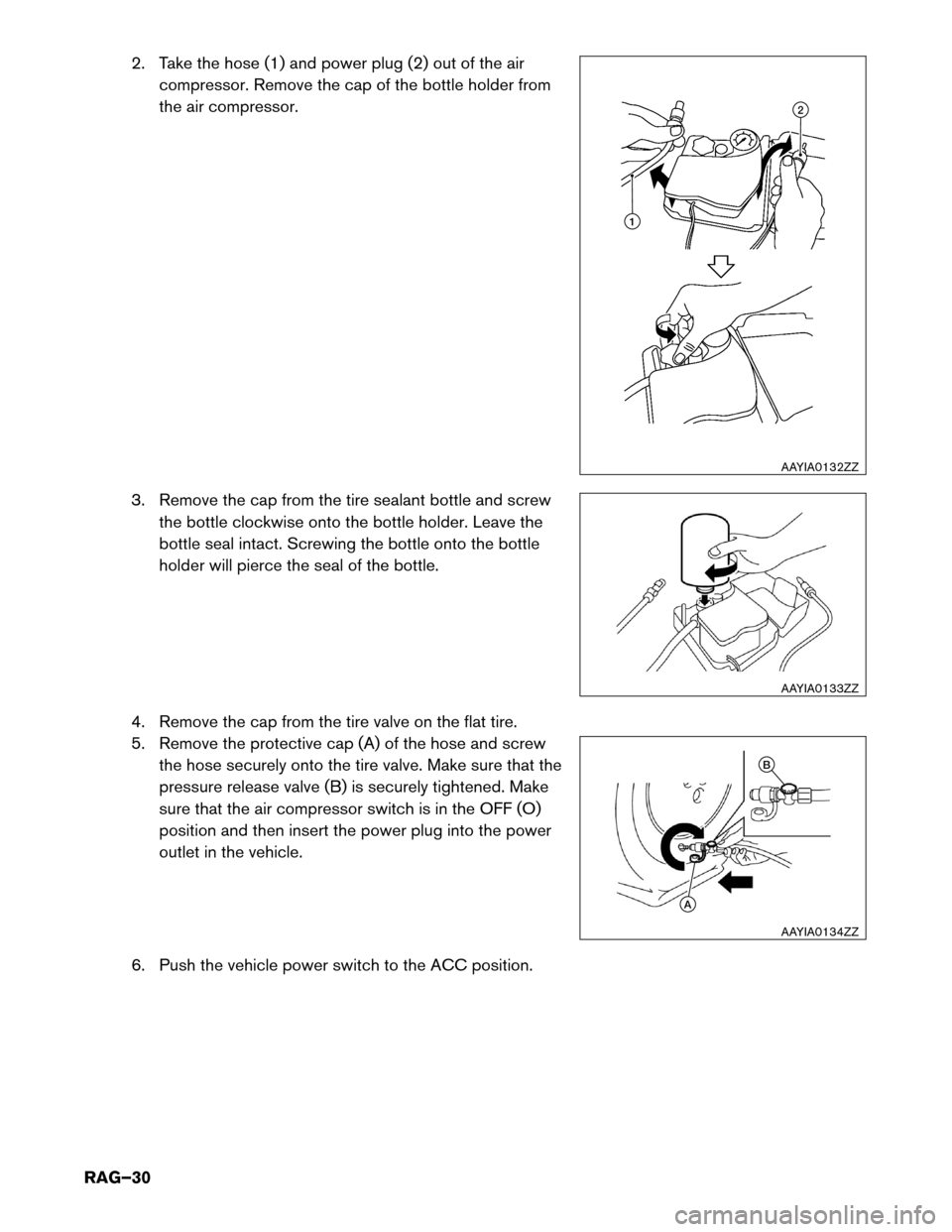
2. Take the hose (1) and power plug (2) out of the air
compressor. Remove the cap of the bottle holder from
the air compressor.
3. Remove the cap from the tire sealant bottle and screw the bottle clockwise onto the bottle holder. Leave the
bottle seal intact. Screwing the bottle onto the bottle
holder will pierce the seal of the bottle.
4. Remove the cap from the tire valve on the flat tire.
5. Remove the protective cap (A) of the hose and screw the hose securely onto the tire valve. Make sure that the
pressure release valve (B) is securely tightened. Make
sure that the air compressor switch is in the OFF (O)
position and then insert the power plug into the power
outlet in the vehicle.
6. Push the vehicle power switch to the ACC position. 2
1
AAYIA0132ZZ AAYIA0133ZZ
B
A
AAYIA0134ZZ
RAG–30